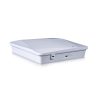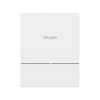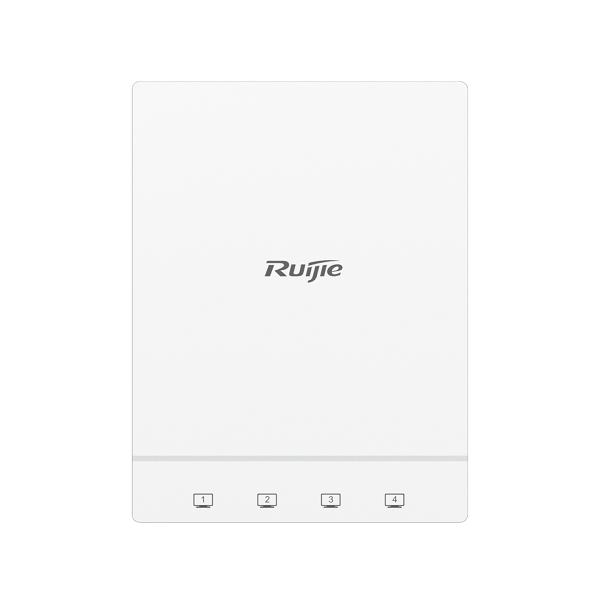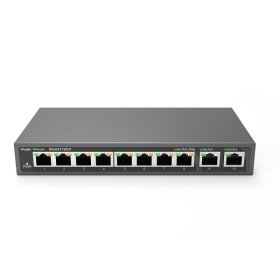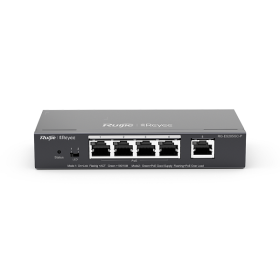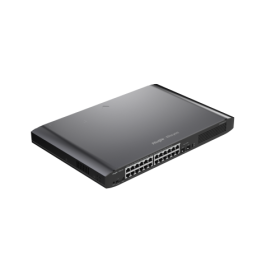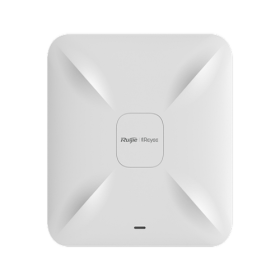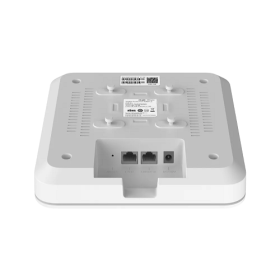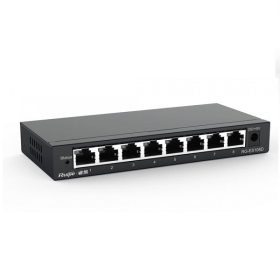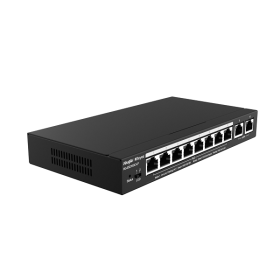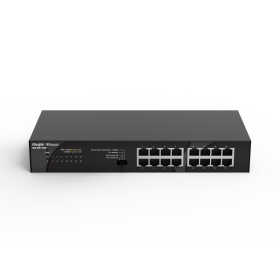- Your cart is empty
- Continue Shopping
Ruijie RG-AP180 Indoor Wall Plate Wireless AP Price in Dubai, UAE
د.إ 373.74
- Multi-service Linkage, All-in-One for Office Scenarios
- 1775 Mbps Ultra-Fast Speed with Wi-Fi 6
- Full-Scenario Enterprise-class Authentication for Enhanced Security
- Ruijie Cloud Management, Intelligent Optimization, and Easy O&M
Product Description
| Dimensions and Weight | RG-AP180 |
| Unit dimensions (W x H x D) | In-wall: 86 mm x 116 mm x 19 mm (3.4 in x 4.6 in x 0.8 in)
Above-wall: 86 mm x 116 x mm x 24 mm (3.4 in x 4.6 in x 1.0 in) |
| Shipping dimensions (W x D x H) | 508 mm x 390 mm x 152 mm (20.0 in x 15.4 in x 6.0 in) |
| Unit weight | 0.22 kg (0.49 lbs) |
| Shipping weight | 0.3 kg (0.66 lbs) |
| Mounting | Wall-mount
Compatible with 86-mm and EU standard junction boxes (if you want to use the US standard junction box, purchase an RG-AP180-MNT mounting bracket separately) |
| Color | Elegant white |
| Wi-Fi Radio | RG-AP180 |
| Radio design | Dual-radio and up to four spatial streams:
● Radio 1: 2.4 GHz, two spatial streams, 2×2 MU-MIMO ● Radio 2: 5 GHz, two spatial streams, 2×2 MU-MIMO |
| Operating frequencies | Radio 1: 802.11b/g/n/ax
● 2.400 GHz to 2.4835 GHz, ISM, channels 1 to 13 Radio 2: 802.11a/n/ac/ax ● 5.150 GHz to 5.250 GHz, U-NII-1, channels 36, 40, 44, and 48 ● 5.250 GHz to 5.350 GHz, U-NII-2A, channels 52, 56, 60, and 64 ● 5.470 GHz to 5.725 GHz, U-NII-2C, channels 100, 104, 108, 112, 116, 120, 124, 128, 132, 136, and 140 ● 5.725 GHz to 5.850 GHz, U-NII-3/ISM, channels 149, 153, 157, 161, and 165 Note: Country-specific restrictions apply. |
| Data rates | Radio 1: 2.4 GHz, 574 Mbps
● Two spatial stream Single User (SU) MIMO for up to 574 Mbps wireless data rate to individual 2SS HE40 802.11ax client devices (max.) ● Two spatial stream Single User (SU) MIMO for up to 287 Mbps wireless data rate to individual 2SS HE20 802.11ax client devices (typical) Radio 2: 5 GHz, 1.2 Gbps ● Two spatial stream Single User (SU) MIMO for up to 1.2 Gbps wireless data rate to individual 2SS HE80 802.11ax client devices (max.) ● Two spatial stream Single User (SU) MIMO for up to 574 Mbps wireless data rate to individual 2SS HE40 802.11ax client devices (typical) ● Two spatial stream Multi-User (MU) MIMO for up to 1.2 Gbps wireless data rate to up to two 1SS HE80 802.11ax DL-MU-MIMO capable client devices simultaneously (max.) ● Two spatial stream Multi-User (MU) MIMO for up to 574 Mbps wireless data rate to up to two 1SS HE40 802.11ax DL-MU-MIMO capable client devices simultaneously (typical) |
| Data rate set | The following 802.11-compliant data rates in Mbps are supported:
2.4 GHz radio ● 802.11b: 1, 2, 5.5, 11 ● 802.11g: 1, 2, 5.5, 6, 9, 11, 12, 18, 24, 36, 48, 54 ● 802.11n: 6.5 to 300 (MCS0 to MCS15, HT20 to HT40) ● 802.11ac: 6.5 to 400 (MCS0 to MCS9, NSS = 1 to 2, VHT20 to VHT40) ● 802.11ax: 8.6 to 574 (MCS0 to MCS11, NSS = 1 to 2, HE20 to HE40) 5 GHz radio ● 802.11a: 6, 9, 12, 18, 24, 36, 48, 54 ● 802.11n: 6.5 to 300 (MCS0 to MCS15, HT20 to HT40) ● 802.11ac: 6.5 to 867 (MCS0 to MCS9, NSS = 1 to 2, VHT20 to VHT80) ● 802.11ax: 8.6 to 1,200 (MCS0 to MCS11, NSS = 1 to 2, HE20 to HE80) |
| packet aggregation | 802.11n/ac/ax: A-MPDU and A-MSDU |
| Antenna type | Built-in intelligent antenna (two 2.4 GHz antennas and two 5 GHz antennas) |
| Max. antenna gain | 2.4 GHz radio: 2 dBi
5 GHz radio: 2 dBi |
| Max. transmit power | 2.4 GHz radio: 20 dBm (17 dBm per chain)
5 GHz radio: 20 dBm (17 dBm per chain) Note: The transmit power is limited by local regulatory requirements. |
| Power increment | Configurable in increments of 1 dBm |
| Radio technologies | 802.11b: Direct-Sequence Spread-Spectrum (DSSS)
802.11a/g/n/ac: Orthogonal Frequency-Division Multiplexing (OFDM) 802.11ax: Orthogonal Frequency Division Multiple Access (OFDMA) |
| Modulation types | 802.11b: BPSK, QPSK, CCK
802.11a/g/n: BPSK, QPSK, 16-QAM, 64-QAM, 256-QAM 802.11ac: BPSK, QPSK, 16-QAM, 64-QAM, 256-QAM 802.11ax: BPSK, QPSK, 16-QAM, 64-QAM, 256-QAM, 1024-QAM |
The following table lists the radio frequency performance of Wi-Fi including different frequency bands, protocols, and date rates. It is country-specific, and Ruijie Networks reserves the right of interpretation.
| Wi-Fi Radio
Frequency Performance |
RG-AP180 | ||
| Frequency Band and Protocol | Data Rate | Max. Transmit Power per Transmit Chain | Max. Receive Sensitivity per Receive Chain |
| 2.4 GHz, 802.11b | 1 Mbps | 18 dBm | –91 dBm |
| 2 Mbps | 17 dBm | –91 dBm | |
| 5.5 Mbps | 16 dBm | –90 dBm | |
| 11 Mbps | 15 dBm | –87 dBm | |
| 2.4 GHz, 802.11g | 6 Mbps | 18 dBm | –89 dBm |
| 24 Mbps | 16 dBm | –82 dBm | |
| 36 Mbps | 16 dBm | –78 dBm | |
| 54 Mbps | 15 dBm | –72 dBm | |
| 2.4 GHz, 802.11n (HT20) | MCS0 | 18 dBm | –85 dBm |
| MCS7 | 15 dBm | –77 dBm | |
| 2.4 GHz, 802.11n (HT40) | MCS0 | 18 dBm | –82 dBm |
| MCS7 | 15 dBm | –64 dBm | |
| 2.4 GHz, 802.11ax (HE20) | MCS0 | 18 dBm | –85 dBm |
| MCS11 | 12 dBm | –58 dBm | |
| 2.4 GHz, 802.11ax (HE40) | MCS0 | 18 dBm | –82 dBm |
| MCS11 | 12 dBm | –54 dBm | |
| 5 GHz, 802.11a | 6 Mbps | 18 dBm | –89 dBm |
| 24 Mbps | 16 dBm | –82 dBm | |
| 36 Mbps | 16 dBm | –78 dBm | |
| 54 Mbps | 15 dBm | –72 dBm | |
| 5 GHz, 802.11n (HT20) | MCS0 | 18 dBm | –85 dBm |
| MCS7 | 15 dBm | –67 dBm | |
| 5 GHz, 802.11n (HT40) | MCS0 | 18 dBm | –82 dBm |
| MCS7 | 15 dBm | –64 dBm | |
| 5 GHz, 802.11ac (VHT20) | MCS0 | 18 dBm | –85 dBm |
| MCS9 | 13 dBm | –60 dBm | |
| 5 GHz, 802.11ac (VHT40) | MCS0 | 18 dBm | –82 dBm |
| MCS9 | 13 dBm | –57 dBm | |
| 5 GHz, 802.11ac (VHT80) | MCS0 | 18 dBm | –79 dBm |
| MCS9 | 13 dBm | –53 dBm | |
| 5 GHz, 802.11ax (HE20) | MCS0 | 18 dBm | –85 dBm |
| MCS11 | 12 dBm | –58 dBm | |
| 5 GHz, 802.11ax (HE40) | MCS0 | 18 dBm | –82 dBm |
| MCS11 | 12 dBm | –54 dBm | |
| 5 GHz, 802.11ax (HE80) | MCS0 | 18 dBm | –79 dBm |
| MCS11 | 12 dBm | –52 dBm | |
| Bluetooth Radio | RG-AP180 |
| Bluetooth | Bluetooth 5.0 |
| Antenna type | Onboard omnidirectional antenna |
| Max. antenna gain | 2.4 dBi, with a downtilt angle of roughly 30 degrees |
| Max. transmit power | 10 dBm |
| Receive sensitivity | –88 dBm (@BLE) |
| Ports | RG-AP180 |
| Fixed service port | Uplink:
1 x 10/100/1000Base-T Ethernet port with auto-negotiation, compliant-with IEEE 802.3af/802.3at standard (PoE/PoE+). Downlink: 4 x 10/100/1000Base-T Ethernet ports with auto-negotiation |
| Fixed management port | 1 x Micro USB console port (under the decorative cover) |
| Status LED | 1 x multi-color system status LED |
| Button | 1 x Reset button
● Press the button for shorter than 2 seconds. Then the device restarts. ● Press the button for longer than 3 seconds. Then the device restores to factory settings. |
| Power Supply and Consumption | RG-AP180 |
| Input power supply | The AP supports the following two power supply modes:
● 12 V DC/1 A power input over DC connector: The DC connector accepts 2.1 mm/5.5 mm center-positive circular plug. A DC power adapter needs to be purchased separately. ● PoE input over the PoE-in port: The power source equipment (PSE) complies with the IEEE 802.3af standard. The IEEE 802.3at (PoE+) standard is backward compatible with the IEEE 802.3af (PoE) standard. Note: ● When powered by 802.3at (PoE+), the AP operates with the optimal performance. ● If both DC power and PoE are available, DC power is preferred. |
| External power supply | Not supported |
| Power consumption | Max power consumption: 10 W
● DC powered: 10 W ● PoE powered (802.3af): 10 W ● Idle mode: 3.3 W |
| Environment and Reliability | RG-AP180 |
| Temperature | Operating temperature: –10°C to +50°C (14°F to 122°F)
Storage temperature: –40°C to 70°C (–40°F to +158°F) Note: At an altitude between 3,000 m (9,843 ft) and 5,000 m (16,404 ft), every time the altitude increases by 220 m (722 ft), the maximum temperature decreases by 1°C (1.8°F). |
| Humidity | Operating humidity: 5% to 95% RH (non-condensing)
Storage humidity: 5% to 95% RH (non-condensing) |
| Environment standard | Storage and operating environment: NEBS GR-63-CORE_Issue3_2006 GB/T 2423.6-1995 |
| Mean Time Between Failure (MTBF) | 200,000 hours (22 years) at the operating temperature of 25°C (77°F) |
| Certifications and Regulatory Compliance | RG-AP180 |
| Regulatory compliance | GB 4943.1
CE Marked, EN300 328, EN301 893, EN 301 489, EN 50121, EN 50155, EN55032, EN55035 EN 62311, IEC/EN 62368-1(replacing IEC/EN 60950-1) RED Directive 2014/53/EU EMC Directive 2014/30/EU Low Voltage Directive 2014/35/EU |
| Certifications | Wi-Fi Alliance:
● 2.4 GHz and 5 GHz Spectrum Capabilities ● Wi-Fi CERTIFIED a, b, g, n, ac, ax (6) ● WPA2™-Enterprise 2018-04 ● WPA2™-Personal 2018-04 ● WPA3™-Personal 2019-08 ● WPA™-Enterprise ● WPA™-Personal ● WMM®, W-Fi Agile Multiband™ |
*For more country-specific regulatory information and approvals, contact your local sales agency.
| Applicable software version | RG-AP180 |
| Applicable software version | RGOS11 |
| WLAN | RG-AP180 |
| Max. number of associated STAs | 512 (up to 256 STAs per radio) |
| Max. number of BSSIDs | 16 (up to 8 BSSIDs per radio) |
| STA management | SSID hiding
Each SSID can be configured with the authentication mode, encryption mechanism, and VLAN attributes independently. Remote intelligent perception technology (RIPT) Intelligent client identification technology Intelligent load balancing based on the STA quantity or traffic |
| STA limiting | SSID-based STA limiting
Radio-based STA limiting |
| Bandwidth limiting | STA/SSID/AP-based rate limiting |
| Wireless roaming | Layer 2 and Layer 3 roaming |
| Security and Authentication | RG-AP180 |
| Authentication and encryption | Remote Authentication Dial-In User Service (RADIUS)
PSK, web, and 802.1X authentication QR code-based guest authentication, SMS authentication, MAB authentication (used with the RG-WS series wireless access controller) Data encryption: WEP (64/128-bit), WPA-TKIP, WPA-PSK, WPA2-AES, WPA3 |
| Data frame filtering | Allowlist, static blocklist, and dynamic blocklist |
| WIDS | WIDS (Wireless Intrusion Detection System)
User isolation Rogue AP detection and containment |
| ACL | Dynamic ACL assignment
● ACL assignment based on time spans ● ACL assignment (complete entry) based on MAC addresses ● Execution of pre-configured ACLs (entry index) based on MAC addresses |
| CPP | Supported |
| NFPP | Supported |
| Routing and Switching | RG-AP180 |
| IP service | Static IPv4 address and DHCP-assigned IPv4 address
NAT ALG FTP and NAT ALG DNS |
| Multicast | Multicast-to-unicast conversion |
| IPv6 basics | IPv6 addressing, Neighbor Discovery (ND), ICMPv6, IPv6 Ping
IPv6 DHCP Client |
| IP routing | IPv4/IPv6 static routing |
| VPN | PPPoE client
IPsec VPN, up to four IPsec tunnels |
| Management | RG-AP180 |
| Network management | NTP server and NTP client
SNTP client SNMP v1/v2c/v3 Fault inspection and alarm Information statistics and logging |
| Network management platform | Web-based management (Eweb) |
| STA access management | Console and Telnet-based management
TFTP Client |
| Fat/Fit/Cloud mode switchover | When the AP works in Fit mode, it can be switched to Fat mode through an AC.
When the AP works in Fat mode, it can be switched to Fit mode through the console port or Telnet. When the AP works in Cloud mode, it can be managed through Ruijie Cloud. |
General Inquiries
There are no inquiries yet.

